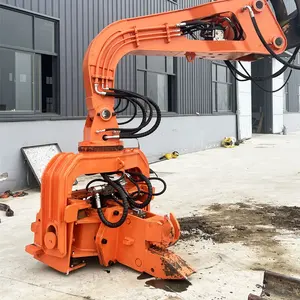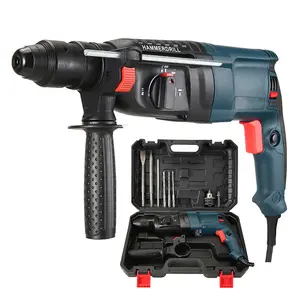
360 Degree Rotation K250 High Frequency Pile Driver Vibro Hammer Hydraulic Excavator Mounted Pile Drilling Machine





















The premier hammer is a fundamental implement across various sectors, epitomizing both utility and resilience. This adaptable tool is crafted to apply force precisely, proving itself essential in fields such as construction, woodworking, and vehicle maintenance. A hammer's effectiveness hinges on its design, composition, and craftsmanship, tailored to withstand the strenuous requirements of professional tasks.
The hammer category boasts considerable diversity. A superior framing hammer stands out with its hefty head, engineered to drive nails swiftly and effectively, making it the go-to choice for framers building large structures. The exemplary claw hammer is indispensable for both woodworkers and homeowners, equally skilled at embedding nails into woodwork and extracting them with precision. For those in automotive or construction, a top-notch air hammer is invaluable, adept at carving through metal and concrete with its potent pneumatic thrusts. Machinists may prefer a ball-peen hammer for its metal-shaping prowess, while electricians might select a lineman's hammer with its straight claw and substantial head, perfectly suited for cable tasks. Each variant is meticulously crafted with specific attributes—mass, equilibrium, claw configuration—to excel in its designated role, be it in precision-driven settings or on robust building sites.
The architecture of a hammer is pivotal to its function. Handles, whether composed of vibration-dampening hickory or robust fiberglass, are built to absorb the shock of continuous impacts. Grips may feature a textured or rubber-padded design for ergonomic comfort and slip-resistant security. The head, firmly affixed to the handle, serves as the tool's powerhouse. In a superior framing hammer, the head is typically weightier, angled to optimize nail-driving power, and may possess a milled face to clasp nails and avert misstrikes. The claw, curved or straight, is designed for maximal leverage and effortless nail withdrawal. In a top-tier air hammer, the structure incorporates an air compressor connection, a trigger for precise control, and an assortment of swappable chisels or points, enabling a multitude of tasks to be executed with both precision and vigor.
The choice of materials for hammer fabrication is crucial. Carbon steel heads undergo hardening and tempering to enhance resilience and extend service life. Some hammers integrate advanced alloys for superior strength or resistance to corrosion. The head's surface may be polished, sandblasted, or coated to fend off the elements and diminish glare. The head's design is also critical, with variations in form and dimensions to accommodate different tasks. For example, the head of a framing hammer is shaped to concentrate force upon impact, while the peen of a ball-peen hammer is rounded to contour metal without inflicting damage. These material and design considerations are the culmination of thorough research and development, aimed at delivering a hammer that can endure professional rigors while offering optimal performance.
In the commercial sphere, the hammer takes on a multifaceted role. In construction, the exemplary framing hammer is vital for erecting edifices, its substantial head enabling workers to penetrate thick materials with minimal strikes. For cabinetry and furniture craftsmanship, the precision of a superior claw hammer is essential for intricate joinery. In automotive repair, a top-notch air hammer swiftly tackles obstinate bolts and rivets or slices through sheet metal with ease. In manufacturing, hammers facilitate shaping, fitting, and assembling components with exactitude. The hammer is more than a mere instrument; it is an enabler of productivity and quality in the production process, contributing to the creation of goods and infrastructure that underpin the economy.
Each hammer is conceived with a suite of functions tailored to particular tasks. A superior framing hammer is constructed to administer forceful blows, expediting the nailing process in construction endeavors. The claw hammer serves a dual purpose, proficient in both embedding and extracting nails from wood. The air hammer, powered by compressed air, is equipped for labor-intensive duties such as slicing metal or dismantling old fixtures. These functions are integral to the hammer's design, shaping the tool's form and features.
The distinctive attributes of a hammer set it apart in a competitive marketplace. A highly-rated framing hammer may feature an anti-vibration design to mitigate arm fatigue. A superior claw hammer could offer a magnetic nail starter for effortless, one-handed operation. The top-notch air hammer might provide variable speed settings, enabling meticulous work on fragile materials. These innovations are not mere conveniences; they are the fruits of ingenuity, crafted to satisfy the evolving demands of professionals across various fields.
The advantages of a well-crafted hammer are manifold. For the tradesperson, it signifies reduced time on tasks, diminished physical effort, and a lower incidence of repetitive strain injuries. For the business proprietor, it equates to heightened productivity, fewer interruptions due to tool malfunctions, and superior craftsmanship. The appropriate hammer can also enhance workplace safety, with features designed to curtail accidents and augment user command.
Selecting the ideal hammer involves discerning the specific requirements of your enterprise. The hammer's weight should align with the user's strength and the job's nature. A more substantial hammer drives nails more effectively but may lead to fatigue over prolonged use. The handle material should offer comfort and shock absorption, while the head material should ensure durability and proper balance. The work environment must also be taken into account; for example, a non-sparking hammer may be necessary in volatile settings.
Proper maintenance is essential to prolong the lifespan of a hammer. Routine cleaning, damage inspection, and correct storage are fundamental. For a superior air hammer, this includes monitoring the air supply for moisture and regular lubrication. For hammers with wooden handles, it is crucial to check for splinters or cracks, while those with rubber grips should be inspected for wear and tear. Diligent upkeep ensures the hammer remains a dependable component of your toolkit for the long haul.
The target market for hammers is as diverse as the tools themselves. A superior framing hammer is directed at construction experts in need of a robust, heavy-duty implement. A superior claw hammer is aimed at general contractors and home improvement aficionados seeking a multipurpose tool for assorted tasks. The top-notch air hammer is indispensable for professionals in the automotive and metalworking sectors who require a potent tool for molding and cutting. Grasping the specific needs and preferences of these groups is vital to supply them with the right hammer that fulfills their demands.
By exploring the extensive selection of hammers on Alibaba.com, businesses can identify the best hammer tailored to their unique needs, from reliable hammers suitable for general tasks to specialized models like the elite hammers for more challenging applications. Detailed product descriptions and specifications on Alibaba.com aid business purchasers in making informed decisions globally.